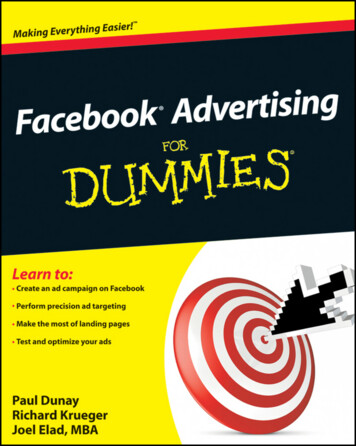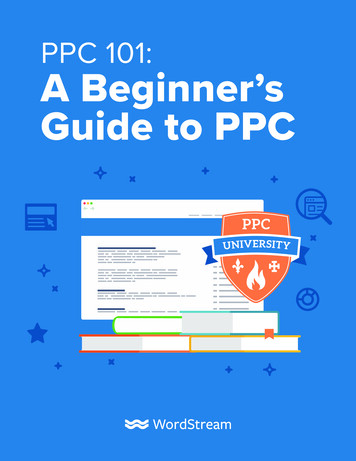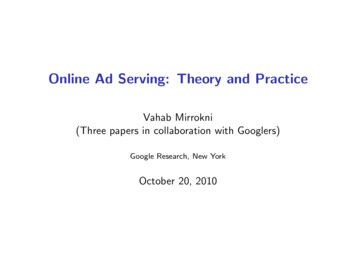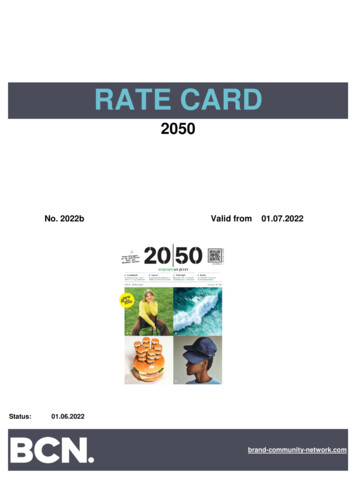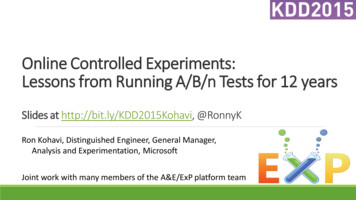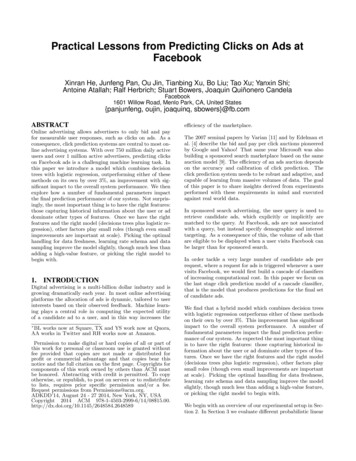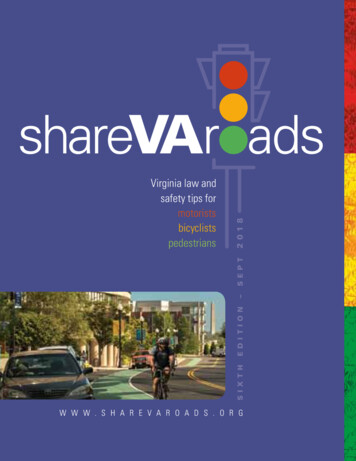
Transcription
S I X T HE D I T I O N–S E P TVirginia law andsafety tips formotoristsbicyclistspedestrians2 018shareVAr adsw w w . s h a r e v a r o a d s . o r g
Share VA Roads offers safety procedures and traffic regulations forall users of Virginia’s roads and paths. This guide will help bicyclists,pedestrians, and motorists safely use Virginia’s transportationnetwork.Like motorists, bicyclists and pedestrians are subject to the Codeof Virginia section on motor vehicles (Title 46.2). For a summary ofVirginia’s pedestrian and bicycling laws, visit: www.virginiadot.org/programs/bk-laws.aspA federal highway safety grant from the Virginia Department ofMotor Vehicles funded Share VA Roads, 6th edition. It has beenprepared by the Northern Virginia Regional Commission withoversight from the Technical Advisory Committee members listedon page 51.2
Table of ContentsShare VA RoadsKnow the Law.5Knowledge to Live By.6Right of Way.8What to Do in a Crash.8MotoristsOn the Road.8Crosswalks.12Passing.15BicyclistsBefore Cycling.18Street Travel.20Sidewalks.23Paths and Trails.23Crosswalks.24Bicyclists’ Side of the Road.25Signals.28Turns.30Blind Spots.32Double Threat.32Passing.33Turning Vehicles.34Commuting.36Roundabout Safety Tips.39PedestriansSidewalks.40Paths and Trails.41Crosswalks.41Pedestrians’ Side of the Road.43Turning Vehicles.43Commuting with Buses and Transit.45Double Threat.46Resources and Learn More.473
This booklet is a good place to start learning the rules and the mostcommon safety practices for all travelers sharing Virginia’s roads, trails,and paths.No matter why they drive, bike, or walk, everyone shouldtravel safely in Virginia.Some people drive because it is convenient. Others do not own orcannot drive a car so they must bike, walk, or use public transportation.People may walk or bicycle for their health, their budgets, andthe environment; or they may walk or bicycle as inexpensive andenvironmentally-friendly options for short commutes to parks, schools,stores, places of worship, and businesses.Everyone uses the roads–know the law and put safety firstEveryone should recognize that motorists, bicyclists, and pedestrianshave mutual rights and responsibilities. When all travelers know thelaw and respect their mutual rights and responsibilities, sharing theroad is safe and predictable.“Every person riding a bicycle on a highway shall be subject tothe provisions of the Code of Virginia section on motor vehiclesand shall have the rights and duties applicable to the driver ofa vehicle unless a provision clearly indicates otherwise.”–Code of Virginia § 46.2-8004
Know the LawTitle 46.2, Chapter 8 of the Code of Virginia contains laws coveringmotorists, bicyclists, and pedestrians in Virginia. All road users shouldread the Virginia Driver’s Manual. www.dmv.state.va.us/webdoc/pdf/dmv39.pdfRights and Duties.§ 46.2-800, 904, 924Definitions. § 46.2-100, 1600, 903, 908.1, 914, 915.2, 1051Traffic Controls.§ 46.2-830, 833Where to Walk. § 46.2-928Where to Ride. § 46.2-802, 808, 826, 903, 904, 905, 907Turning and Changing Directions. § 46.2-846, 847, 848, 849Passing a Bicyclist. § 46.2-839Care When Opening Motor Vehicle Doors. § 46.2-818.1Passing on a Bicycle. § 46.2-839, 907Slow Down, Move Over for Stationary Vehicles. § 46.2-921.1Bicycle Safety and Helmets. § 46.2-906, 906.1, 932, 1078Bicycle Lights and Equipment. § 46.2-1015, 1066Bicycle Registration. § 46.2-908, 15.2-1720Crashes.§ 46.2-894, 895, 896Mopeds, Electric Bicycles. § 46.2-100, 903, 908.1, 914, 915.2, 1051“The drivers of vehicles entering, crossing, or turning atintersections shall change their course, slow down, or stop ifnecessary to permit pedestrians to cross such intersections safelyand expeditiously.Pedestrians crossing highways at intersections shall at all timeshave the right-of-way over vehicles making turns into the highwaysbeing crossed by the pedestrians.” –Code of Virginia § 46.2-9245
Knowledge to Live ByMotorists must respect bicyclist and pedestrian rights:Always: Approach and pass bicyclists at a reasonable speed and witha safe gap of at least three feet Yield to pedestrians and bicyclists who are crossing the roadin a crosswalk, especially when turning Allow pedestrians time to cross safely Leave room for bicyclists sharing the road Come to a full stop for a pedestrian using a cane or guide dog, asthis indicates blindness or vision impairment (Class 3 misdemeanor)Don’t: Drive while using mobile devices, or other distractions Honk, yell out to, or crowd bicyclistsBicycles are vehicles when ridden on roads and streets,and bicyclists must abide by the same laws:Always: 6Obey all traffic signs, signals, lights, and markingsWear a helmet – it reduces the chance of a head injuryLook LEFT-RIGH T-LEFT when turning or crossingTravel in the right lane, designated bike lane, or shoulder ifsignificantly slower than trafficRide on the right side with traffic; take a lane if saferRide no more than two side-by-sideUse motor vehicle turn lanes when turningRide single file when moving slower than traffic
Obey signs that restrict riding on interstate highways andlimited access roads Call out or ring a bell to alert others when approaching from behindor passing on a sidewalk or path Carry children securely in special seats or trailers and make surethey wear a helmet Use white headlamps visible 500 feet, rear reflectors, and a redtaillight when bicycling between sunset and sunriseDon’t: Carry passengers on bicycles built for one rider Wear earphones in both earsPedestrians have rights and responsibilities:Always: Watch for motorists, other pedestrians, and bicyclistsBe alert to surroundings and listen for bicyclists and carsUse sidewalks or paths if availableUse crosswalks wherever possibleLook LEFT-RIGHT-LEFT when crossingOn roads without a sidewalk, face traffic and travel on the edgeor shoulder Obey Walk/Don’t Walk control signals and countdown timers Use caution when crossing, give time for vehicles to stop Be visible. Wear something light or reflective after dark.Don’t: Use mobile devices when crossing the street Text and walk Wear earphones in both ears7
Right of WayPedestrians have the right of way on sidewalks.In spite of this, pedestrians can avoid crashes by paying attention tomotor vehicle and bicycle traffic. Pedestrians should use eye contactand gestures to alert drivers when crossing roads from sidewalks,crosswalks, paths, and driveways.Bicyclists must yield the right of way to pedestrians. Bicyclists canlegally ride on sidewalks, unless prohibited by local ordinance or trafficcontrol device. When approaching a pedestrian, bicyclists must slowdown, ring a bell, or give an audible warning such as “bike passing” andwait for the pedestrian to move over.Bicyclists on sidewalks should slow down to watch for motoristsentering a road, intersecting sidewalk or driveway. Motorists’ views areoften obstructed by parked cars or other objects.Motorists should yield right of way to pedestrians and bicyclistsand watch for turning across sidewalks, into driveways, or acrosscrosswalks. By law, motorists must approach and pass a bicyclist at areasonable speed, at least three feet away from the bicyclist.What to Do in a CrashCheck if someone is injured, call 911 immediately. If trained, administerfirst aid, remove the injured from harm’s way, and assist until firstresponders arrive. Severely injured persons should not be moved.8
Persons rendering emergency care orobstetrical services are exempt fromliability, as noted in Virginia’s GoodSamaritan law.Crosswalk: Whereversidewalks meet the streetand where streets intersect,a crosswalk exists, whetherpainted on the road or not.Those involved in a crash, includingpassengers, should exchange legalnames, addresses, and contactinformation. Drivers should provide:Shared-use path: Facilitiesphysically separated frommotorized vehicular trafficby an open space or barrier.Shared-use paths may be usedby bicyclists, pedestrians,skaters, users of wheelchairconveyances, and other nonmotorized activities. Alwaysyield to slower users. Name and address Vehicle registration number Driver’s license number Insurance company and policy numberDocument what happened, including anyinjuries or damage with photos as soonas possible. Save all receipts and repairestimates.If bicyclists have coverage, they shouldcontact their insurance company.Bicyclists and pedestrians shouldalways carry identification and medicalinsurance information, especially whentraveling alone.Bicycle lane: That portion ofa roadway designated by signsand/or pavement markings forthe preferential use of bicycles,electric power-assisted bicycles,and mopeds.Highway: The entire widthbetween the boundary linesof every way or place opento the use of the public forpurposes of vehicular travel inthe Commonwealth, includingstreets and alleys.9
On the RoadBike lanesBike lanes separate bicyclists from other traffic. They may bemarked by signs as well as white lines and symbols applied tothe pavement. Motorists should not park in bike lanes.motoristsMotorists should not drive in a bike lane except when turning right.Before crossing a bike lane to turn, they need to scan for bicycliststo the right and rear, use a turn signal, scan again for bicyclists, andthen merge into the bike lane for the turn.Bicyclists and motorists must share the road, whether or not bikelanes are provided.SharrowsShared Lane Markings (Sharrows) are road markings used toindicate where a bicyclist should be riding in the lane. They are usednext to parked cars to help a bicyclist avoid being hit suddenly bycar doors being opened and on lanes that are too narrow for carsand bicycles to comfortably travel side byside in the same lane. Occasionally they areused on steep downhill slopes to allow thebicyclist more maneuvering space to reactwhen traveling at a high speed. Sharrowsare an indicator that motorists should notattempt to pass the cyclist; there is notenough room for the cyclist and motorist tofully share the lane.10
Motorists: StopMotorists are required to come to a complete stop at red trafficsignals and STOP signs. Before turning right on red, motorists mustSTOP, look LEFT-RIGHT-LEFT, then proceed. The most dangeroussituation for bicyclists and pedestrians is at intersections wheremotorists fail to come to a stop.11
motoristsCrosswalksWhat is a crosswalk?Crosswalks might not be marked or painted on the highway.Wherever sidewalks meet the street and where streets intersect,a crosswalk exists, whether painted on the road or not. – Code ofVirginia § 46.2-924Motorists and bicyclists: Yield to pedestriansMotorists and bicyclists must yield to pedestrians in crosswalks,both marked and unmarked.12
Don’t block the crosswalkA driver should not pass the white stop bar and encroach on thecrosswalk while waiting for the signal to change. Doing so preventswalkers and bicyclists from safely using the crosswalk in frontof the car.Similarly, a driver should not enter the intersection until thereis sufficient space to clear the intersection on the other side.Otherwise he will end up blocking the crosswalk on the far side.Be awareMany pedestrian-motorist crashes occur when the pedestrianis crossing the road, either mid-block or at intersections.13
Drivers: look left-right-leftIn addition to looking for other motor vehicles, motorists shouldlook LEFT-RIGHT-LEFT for bicyclists and pedestrians, particularlyat heavily used intersections and trail intersections.Trail and road intersectionsmotoristsMotorists should consider trail intersections as they would otherintersections. Trail crossings are intersections even if crosswalksare not marked.Motorists: Slow downSpeeding is a major factor in crashes with pedestrians. In past fiveyears, from 2012 through 2017, there were 87 pedestrian deaths onVirginia’s roads where speeding was a factor. Vehicles traveling atrelatively low speeds can cause serious injury and fatalities.14
PassingSlow Down to Get Around: Passingemergency and stopped vehicles,mail, tow and trash trucksWatch for stopped emergency vehiclesand trash collectors. Waste collectionworkers are frequently at risk, as theyare in our neighborhoods on a regularbasis. Drivers need to be mindful that when they see a collectionvehicle on the road, there often is a worker on the street or near thetruck. The “Slow Down to Get Around” law requires drivers passingstopped collection vehicles to slow down to at least 10 miles perhour below the posted speed limit and provide at least a two-footcushion between their vehicle and the collection vehicle. Violationsare punishable by fines. – Code of Virginia § 46.2-921.1Encountering bicyclists and pedestriansWhen there is no sidewalk or shoulder, motorists need to look forPEDESTRIANS that may walk along the shoulder or edge of theroad. Pedestrians are safest if they walk facing traffic.Ride RIGHTWatch for BICYCLISTS using the right side of a two-way road.Transit and rideshare: watch for exiting, boarding andpassing stopped vehiclesBuses and traffic stopping often could mean pedestrians are exitingand crossing in front of buses or ride shares.watch before passingstopped vehicles to reduce the risk of hitting a pedestrian or cyclistcrossing in front of a stopped vehicle.15
Driving with bicyclists on the roadThe law requires that motorists distance themselves at least threefeet from bicyclists as they pass them. Motorists may legally crossthe double yellow line in order to safely pass a cyclist, as long as theoncoming lane is clear.motoristsMotorists should give cyclists extra room and use caution whenturning, in case cyclists are in the blind spot. When turning at anintersection, motorists need to watch for bicyclists and pedestrianscrossing in front.Keep a safe distanceMotorists must be mindful of their surroundings whenever they opentheir door on the side of passing traffic. It is the responsibility of themotorist to ensure their door will not obstruct the path of a passingbicyclist.If a motorist or passenger gets out of a vehicle in line with a cyclist,hitting them with the door, the vehicle is at fault. Virginia law levies afine on drivers who open a vehicle door on the side of passing trafficwithout confirming that it was “reasonably safe to do so.” –Code ofVirginia § 46.2-818.116
Backing outBefore backing out of a parking space or driveway, motoristsshould look behind, left, and right to make sure it is clear beforeproceeding.Dutch ReachThe Dutch Reach is opening the car door using your ‘far hand’,allowing your body to pivot to look behind. This helps minimize thechance of “dooring” a cyclist or being hit by oncoming traffic. Beforeopening the door, look out at your mirror and toward the back of thecar for bikes and traffic.17
Before CyclingBike fitting Bicyclists need a bike that fits. Local bike shops can identify a bike that fits the rider’s needs.bicyclistsThey will explain features and teach gear and brake use. Mostbike shops also sell safety equipment. Size: Having a bike that fits the user is important for safety andcomfort. A rider should reach the pedals and handlebars easily;this reduces difficulty in controlling the bike. Style: Road bikes have narrow tires and dropped handlebars andare designed for faster riding. Mountain bikes have wide tiresand are designed for off-road or winter use. A hybrid or city bikecombines features for comfort and efficiency.Bike check Cyclists should regularly inspect their bicycle or take bikes to abike shop for inspection. Air: Tires should be at the recommended pressure and ingood condition. Brakes: The rider should be able to reach the brake levers,and the brakes should stop the wheels. Chain: The chains should spin and change as gears are engaged. Lights: Bikes require a white front light that is visible from atleast 500 feet and a red rear reflector that is visible at least600 feet to the rear after dusk. If a cyclist is riding on roads18
with a speed limit of 35 mph or greater, they must have anadditional rear red taillight that is visible from at least 500 feet.More light means more visibility.Bike helmets All cyclists should wear a helmet. Bicyclehelmets greatly reduce the risk of seriousbrain injury from a bicycle crash. There is no statewide helmet law, but the–Code of Virginia § 46.2-906.1givesa county, city, or town the authority torequire anyone 14 years old or younger towear a helmet when riding or being carriedon a bicycle. Virginia Department of Vehicles maintains a list of localitieswith helmet laws. www.virginiadot.org/programs/bikeped/laws and safety tips.asp#Helmet%20use When buying a helmet, look for the Consumer Product SafetyCommission (CPSC) label. Helmets should sit level and not shifteasily. V-straps should fit beneath the ear lobes. The chin strapshould be snug, about two fingers’ width under the chin. The National Highway Traffic Safety Administration offersillustrated instructions. www.nhtsa.gov/bicycles Crash it, trash it. If a helmet hits a hard surface in a crash,the cyclist should replace it due to potentially hidden damageto the helmet.19
bicyclistsStreet TravelBike lanesBike lanes are for bicyclists. They are marked with white lines andicons/symbols on the pavement.Bicyclists and motorists must share the road, whether or not bikelanes are provided.Ride in a straight lineBicyclists should be predictable; do not weave in and out betweenparked cars. Drivers can’t always see bicyclists in the parking areasand may unintentionally squeeze them when they try to merge backinto traffic.Bicycling side by sideTwo bicyclists may ride side by side, but only if they don’t impedeother traffic. If riding side by side will prevent cars from passingthe bicycles at a safe distance (three feet), bicyclists must ridesingle file.20
Take the laneSharrowsBicyclists are more visible andless likely to be passed tooclosely when they “take thelane.” Ride near the center ofany travel lane of ordinary width(10-12 feet), when travelingclose to the speed of othertraffic and when approachingintersections, driveways, andalleys. Controlling the laneimproves a bicyclist’s visibility bykeeping out of motorists’ blindspots. It improves positioning atintersections to reduce conflictswith turning traffic. It alsoprevents motorists from trying tosqueeze by within the same lanewhen there is inadequate space.Shared LaneMarkings(Sharrows) areroad markingsused to indicatethe safest placeto ride within thelane. They are used next toparked cars to help a bicyclistavoid being hit by car doorsbeing opened and on lanes thatare too narrow for cars andbicycles to comfortably travelside by side in the same lane.Occasionally sharrows areused on steep downhill slopesto allow the bicyclist moremaneuvering space to reactwhen traveling at a high speed.21
Comfort levelsEasy: Multi-use paths and quiet neighborhood streets(recommended for users of all ages and abilities due to lower trafficspeeds and volume).bicyclistsMedium: Roads with moderate volume of traffic, where riders mayinteract more with motor vehicles, especially at intersections.Difficult: Routes with higher traffic volumes or high traffic speeds,often without bike lanes or shoulders.Keep a safe distanceBicyclists should avoid traveling tooclose to parked cars to avoid therisk of having a door open in frontof them.The bicyclist in the photo below iscorrect. He has taken the lane andis traveling at least five feet fromparked cars to stay out of their dooropening zone.Virginia law fines drivers who opena vehicle door on the side of passingtraffic without confirming that itwas “reasonably safe to do so.”–Code of Virginia § 46.2-818.122
SidewalksBicyclists are permitted to ride on the road or sidewalks (unlessprohibited by the local jurisdiction). When riding on a sidewalk,yield to pedestrians and be especially mindful of slower sidewalktraffic. Bicyclists must audibly warn pedestrians when passing them,preferably with a bell. They must always pass on the left.Paths and TrailsShared-use paths and recreational trailsShared-use paths and recreational trails are physically separatedfrom motorized vehicular traffic by an open space or barrier. They arelocated within the highway right of way or within a separate rightof way. Shared-use paths may be used by bicyclists, pedestrians,skaters, users of wheelchair conveyances, joggers, and other users.Faster users must yield to those who are slower.23
Bicycling with pedestrians and animals on the trailBicyclists must watch for unpredictable users, such as dogs onleashes, children learning to bike, skaters, or, in some cases, horses.When approaching animals, cyclists can avoid scaring them byslowing down. Gently saying “hello there” or “is it safe to pass?”can calm a horse and rider. In tight places, cyclists should dismountand walk past.bicyclistsBicyclists and pedestrians should stay to the right on shared-usepaths, except to pass on the left.At mid-block crossings with the road, users need to watch foroncoming traffic and look LEFT-RIGHT-LEFT. All path users mustobey signals.Bicyclists have the rights and responsibilities of pedestrians whenon a shared-use path.Bicyclists on multi-use trails and on the road must obey the lawspertinent to the trail or road.CrosswalksYield to pedestriansBicyclists must yield to pedestrians in crosswalks,both marked and unmarked.Experienced bicyclists stay on the roadConfident riders can ride on the road as vehicleswhen using intersections.24
Do not ride in crosswalks or alternate between the sidewalkand road by hopping the curb or using driveway cuts. Ride withconsistency and predictability. Before a bicycle trip, plan ahead toensure the route is safe. Resources produced by local governments,as well as online mapping tools, allow bicyclists to know the roadconditions they will encounter and plan according to their skill level.Less-confident bicyclistsBicyclists who feel more comfortable riding on sidewalks mustfollow pedestrian rules at crosswalks. When riding on the sidewalk,bicycles must maintain a lower speed and yield to pedestrians.Bicyclists’ Side of the RoadHow far to the right?Bicyclists should not hug the curbor road edge since this positionmakes them less visible to motorists,promotes unsafe motorist passing, andexposes bicyclists to various hazards.While bicyclists are required to stay“as far right as safely practicable,”when a lane is less than 14 feet wide itis not practical to share the lane with acar. Bicyclists should position themselves to maximize visibility andvantage, and to discourage motorists from turning right into them.Bicyclists may use the shoulders or take the lane.25
bicyclistsRide RIGHTBICYCLISTS use the right side of a two-way road.Choose a laneWhen approaching an intersection, bicyclists should select therightmost lane that serves their destination. Do not ride in a turnlane unless planning to turn. Bicyclists should not travel betweenlanes of traffic moving in the same direction, exceptwhere one lane is a separate or mandatory turn lane.Never face trafficRiding a bike the wrong way through traffic is against the law andis a leading cause of crashes. Bicyclists may think they are safe iflooking at oncoming traffic, but it is more dangerous. If hit head on,the impact would be greater than if hit from behind.When wrong-way riding, bicyclists can’t see signs and trafficsignals. Also, motorists are not expecting bicyclists to beapproaching from that direction.26
Take a classClasses offer opportunities to learn how to ride a bike in a safeenvironment, improve riding skills, and increase rider confidence.Bicycle education courses are offered by League of AmericanBicyclists-certified instructors and are designed for people ofall ages and riding abilities. www.bikeleague.orgBicycling across railroad tracksCyclists must cross railroad tracks carefully. Watch for unevenpavement and grooves that could catch a wheel. Stay in control ofthe bicycle. Cyclists should rise up from the bicycle seat and bendarms and legs so the body acts like a shock absorber.If the tracks crossthe road at a sharpangle, cyclists shouldsignal and scan forapproaching traffic,then angle the bicycleto cross perpendicularto the tracks.27
SignalsHand signalsbicyclistsBefore turning or moving, cyclists should always look behind for,and yield to, any closely approaching traffic in their new line oftravel. To signal a left turn, look behind and then hold out the leftarm. To signal a right turn, look behind and then either hold out theright arm or hold the left arm up, with elbow bent up. Return bothhands to the handlebar before turning, to maximize control whileturning. To signal a stop hold either arm down at an angle, but useboth hands for braking when necessary.Traffic signalsSome traffic signals are triggered by electrically charged wiresburied under the pavement. As a vehicle passes over them, themetal in the vehicle disrupts the current, turning the signal. Not allbicycles have enough metal to trip the signal. To trigger the camera,“white line get behind” is common practice. Some jurisdictions may28
have a bicycle symbol near the line to show where to stop to turnthe signal. If a light does not trigger, a bicyclist can move forwardto let a car trigger the signal, go to the sidewalk and cross withpedestrians, or proceed with caution after waiting two minutesor through two cycles if all traffic is clear.Bicycling with trafficIn Virginia, bicycles are vehicles when on the road. Bicyclists andmotor vehicle drivers share mutual rights and responsibilities asusers of public roads. When bicyclists are in command of theirvehicles and when motorists see bicyclists acting predictably,the highways are safer for everyone.Be awareBicyclists should use mirrors and/or turn their head and look back toscan, just as they would if driving a motorized vehicle.In Virginia, it’s against the law for bicyclists to wear earphones inboth ears while riding. –Code of Virginia § 46.2-107829
TurnsWhen approaching an intersection with several lanes, bicyclistsshould choose the rightmost lane appropriate for their intendeddirection, using turn lanes if appropriate.Turning rightbicyclistsBicyclists should always scan for vehicles that may be turning right.Signal ahead of the intersection. Cyclists should turn right from theright side of a straight lane or right turn lane if available. Bicyclistsmust stop at red lights before turning right. Motorists must watchfor bicyclists.Turning left1. The illustration to the right shows how bicycles turn leftas a vehicle. Bicyclists must: Look over their left shoulder for traffic while approaching the 30intersection. They should practice this until they can performit without swerving.Watch for approaching motor vehicles.Signal a left turn.When traffic is clear, move to the l
all users of Virginia's roads and paths. This guide will help bicyclists, pedestrians, and motorists safely use Virginia's transportation network. Like motorists, bicyclists and pedestrians are subject to the Code of Virginia section on motor vehicles (Title 46.2). For a summary of

